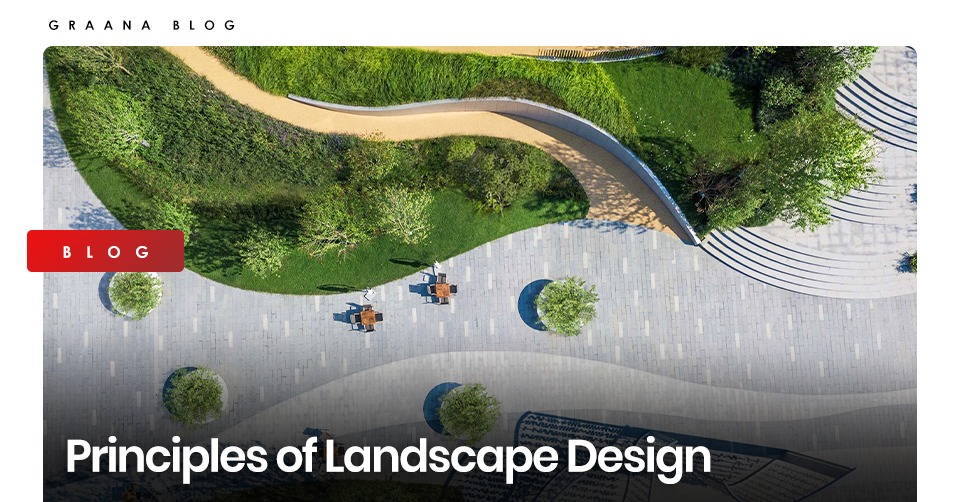
To create a landscape and work through the design process, you must understand the principles of design. Understanding the landscape design principles will help you be more creative while also generating fresh ideas. An incredible landscape design can not only inspire your creativity but also ensure that the features in your design are balanced and harmonious.
The instructions or recommendations for assembling the elements that compose the landscape design are the principles. The principles of landscape design serve as guidance for arranging or organizing the characteristics to create an aesthetically beautiful landscape. The ideas of balance, order, repetition, and unity can be used to create a harmonic symphony. All of the principles are interconnected, and implementing one aids the implementation of the others.
These approaches are used to create physical and psychological comfort. Landscapes that are well-organized and have predictable patterns make people feel at peace. In a landscape with proportions that are appropriate to the human scale, users feel more physically comfortable, function better, and feel more secure. Graana.com, the smartest real estate portal, brings you all you need to know about the principles of landscape design.
The concept of balance is the concept of equal visual appeal and weight, usually centered on a real or imaginary central axis. It is a very important principle of landscape design. Balance is affected by form, color, size, and texture. Asymmetrical, asymmetrical, or perspective balance are three types of balance. In symmetrical balance, the landscape composition is balanced using the same components and objects on both sides, whereas in asymmetrical balance, the landscape composition is balanced using various elements and items with almost equivalent imaginary weight.
The balance of the foreground, midground, and background is what perspective balance is all about. Because they are closer to the spectator, the things in front of the viewer have more visual weight while gazing at a composition.
Unity in a landscape design is to develop a constant character in the composition, and link parts and features together. The thought of everything fitting together is frequently referred to as harmony. To create unity in a landscape, techniques like dominance, connectivity, unity of three, and simplicity are employed. Arranging colors, textures, and forms also help to achieve unity.
The most straightforward technique to achieve unity is to employ a design theme or style. Design themes and styles have a well-defined set of characteristics that have remained popular over time due to their aesthetic appeal. Unity – an extremely vital principle of landscape design provides comfort to the viewer’s eyes but sometimes slight variations are also necessary to keep things interesting.
The recurrent use of elements or characteristics to create patterns or a sequence in the landscape creates repetition. In the landscape, rhythm is created by repeating line, form, color, and texture. Repetition must be utilized with caution; too much can lead to boredom, while too little can lead to confusion. The use of the same object in a line or the grouping of a geometric form in an orderly pattern is known as simple repetition.
Another technique to make repetition more intriguing is to use gradation, which is the progressive shift in specific aspects of a thing. e.g. Using a geometric pattern that progressively gets tinier or larger. Patterns aren’t always created by repetition; sometimes it’s just the utilization of the same color, texture, or form repeatedly throughout the area.
The size of one thing in relation to other objects is known as relative proportion. The scale or size of an object is known as absolute proportion. Because the size of other objects is viewed relative to humans, the human scale is an important absolute scale in design. Plant material, garden structures, and ornaments should all be scaled to human proportions. The size of the house, yard and planting area are all essential relative proportions. Proportion is one of the most visible principles of landscape design.
Principles of landscape design aim to solve problems by combining science, aesthetic composition, and spatial layout to create appealing and effective outdoor spaces. To build spaces, connect them, and make them aesthetically pleasing to the eye, the aforementioned principles of landscape design must be factored into the equation.
For more information follow our blog at Graana Blog.
ISLAMABAD: Capital Development Authority (CDA) is currently undertaking a major Rs652 million project to upgrade…
Karachi – Mayor Barrister Murtaza Wahab has announced the launch of a citywide anti-encroachment operation…
ISLAMABAD: CDA Chairman Muhammad Ali Randhawa has directed the immediate restoration of 23 non-functional water…
ISLAMABAD: In a major relief for the real estate sector, the federal government has decided…
DHA Islamabad-Rawalpindi (DHAI-R), one of the most trusted names in Pakistan’s real estate landscape, is…
ISLAMABAD: Chairman Capital Development Authority (CDA), Muhammad Ali Randhawa, chaired a comprehensive review meeting on…